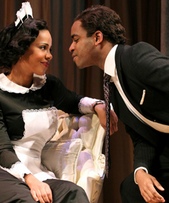SITE GUIDE
SEARCH
REVIEWS
REVIEW ARCHIVES
ADVERTISING AT CURTAINUP
FEATURES
NEWS
Etcetera and
Short Term Listings
LISTINGS
Broadway
Off-Broadway
NYC Restaurants
BOOKS and CDs
OTHER PLACES
Berkshires
London
California
New Jersey
DC
Connecticut
Philadelphia
Elsewhere
QUOTES
TKTS
PLAYWRIGHTS' ALBUMS
LETTERS TO EDITOR
FILM
LINKS
MISCELLANEOUS
Free Updates
Masthead
A CurtainUp Review
By the Way, Meet Vera Stark
By Elyse Sommer
|
How come in Los Angeles nobody actually does what they do?
And everybody's always on there way to something else. Something grander. — Vera who, undiscouraged by the pipe dream reality all around her, sticks her own dream of a film career. People want to laugh, they want to cry and they want a little song and dance in between. And I don't think that's so fucking awful. But the one thing they don't want is to feel bad about themselves. Not now, not while the economy is dying and good folks are being forced out of their homes and into the fucking gutter. People need the past, need their history to seem heroic, glorious and romantic. That is what we do, erase their pain for ninety minutes. And let's face it slavery ain't exactly a pick me up. All I'm asking is that if you're gonna give `em slaves, give ` em happy ones. —Slasvick, the Hollywood Studio mogul who sums up the mercenary philosophy that made black actors resort to playing inauthentic and usually minor roles and often assuming faux identities. |

Sanaa Lathan and Daniel Breaker
(Photo by Joan Marcus) |
In 2004 she had two plays about African-American women produced at major Off-Broadway venues, Intimate Apparel and Fabulations. With Intimate Apparel set at the turn of the twentieth century and Fabulation at the turn of the twenty-first, I found myself wondering (hoping!) that Nottage might be planning for Intimate's Esther and Fabutlation's Undine to be part of a whole series of plays about African-American women's experiences in various decades, shades of August Wilson. While she left America for the Congo with her next play, Ruined, it was a triumphant departure (geographically — though not from her examination of female exploitation and stereotyping) that garnered her a place in the pantheon of Pulitzer Prize winners
With By the Way, Meet Vera Stark, Ms. Nottage has now completed a trilogy about the African-American experience, this time through the story of one young woman longing for a chance to see herself on the silver screen, even if only as a maid. It's a comedy modelled on the screwball genre.
Though focusing on young Vera Stark's compromise to get her share the Hollywood dream, Nottage has surrounded her with other equally engaging characters to represent numerous e real inspirational sources (think Hattie McDaniel, Louise Beavers, Dorothy Dandridge — and Ms. Nottage's specific inspiration, actress Theresa Harris whose films included Babyface with Barbara Stanwyck). Vera Stark also works as an all embracing satire of our entire society's preoccupation with fame and the consequent elevation of pop culture to high art worthy of serious scholarship.
The cleverly written script is full to the brim with acting opportunities, hilarious scenes and imaginative stagecraft, all of which are fully realized under Joe Bonney's direction. Even if it wasn't as smart and entertaining as it is, By the Way, Meet Vera Stark would be worth seeing for Sanaa Lathan's phenomenal performance as the title character, both as the young Vera, and the almost unrecognizable one we see when the play fast forwards to her last public appearance on a 1973 TV interview show.
The rest of the cast is also outstanding. Stephanie J. Block is terrific as the hard-drinking, self-absorbed movie star with whom Vera has a beyond maid and boss relationship. The five other characters handle several personas with panache.
The play is at its satiric best during the 1933 first half of the story that begins with Vera coaching her boss Gloria for the starring role in a film to be called The Belle of New Orleans "which every actress with half way good teeth wants" Both women are 28 and have been around Hollywood long enough for Vera to be less likely to be discovered without a lucky break and Gloria, a.k.a as "America's little sweetie pie" having passed her "most beautiful young starlet on scene" days which means that she has to audition for plum roles.
When the scene shifts to the far less luxurious apartment Vera shares with her friend Lottie (the first of three roles by the endearing Kimberly Hebert Gregory), we get some of Nottage's funniest and most astute dialogue about Hollywood as a talent wasteland for women of color. We learn that the plump Lottie's stage acting successes have not translated into a career. As she explains Hollywood demands that women like her "gotta be high yella mellow or look like you crawled outta Mississippi cotton patch to get work." Consequently she's "spent seven years trying to eat my way into some work, looking like someone's mammy." We also meet neighbor Anne Marie (Karen Olivo who distinguishes herself even without singing and dancing as she most recently did in West Side Story), who's willing to totally change identities to break down the racial barrierr, only to amusingly turn up as a militant activist during the latter part of the play.
The 1930's part of the play ends with a true screwball-y finale, a party given by Gloria for the studio mogul Frederick Slavsvick (played with acerbic wit by David Garrison) that brings the whole cast on scene: Lottie as an extra maid, Anne Mae on the arm of Belle of New Orleans director Maxmillian Von Oster (a hilariously phony Kevin Isola) masquerading as an Argentinian glamour girl.
Also part of this first act finale is Leroy Barksdale (an irresistibly winning Daniel Breaker), the man who steals Vera's heart. While currently working as Slavsvick's chaufferr, he's also determined to achieve more, but without compromising himself. He's made a first step towards this end by learning to read and write music and thus not let his creative efforts fizzle into nothingness, as so many jazz musicians he's met do. To him the willingness of "half the Negroes in this town are running around like chickens without heads trying to get five minutes of shucking and jiving time, all so they can say they're in the pictures" is an unworthy effort — " just lights and shadows."
But Vera has struggled to achieve that lights and shadows dream and her easy mimicry of the Negro stereotype Van Oster sees as authentic marked the first step in her ability and willingness to do whatever it takes to "have a taste of what Gloria's got". As the rococo curtain drops we know that there's no turning back from the bridge that she's crossed.
The shift to the aftermath of the campaign by Vera, Gloria, Lottie and Anne Mae to be cast in the New Orlean's tear jerker takes us to 2003 and 1973 simultaneously. Downstage we have Herb Forrester (Daniel Breaker again, and again delightful),, a pompous academic leading a seminar about Vera Stark. Yes, Gloria's maid who did, like Gloria get cast in The Belle of New Orleans — Vera as Tillie the maid and Gloria as the identity denying, doomed to die Camille-like heroine who's become an iconic mystery figure for film historianss. These pop-scholars, and we with them, study a 1973 television show further upstage. It's hosted by Brad Donovan (David Garrison handily channeling what could be any TV interviewer of the era) on which a blowsy but flamboyantly colorful Vera is joined by a surprise guest: Gloria, a now rather proper Londoner married to a symphony conductor. The second act's satire is fun but not quite on a level with the 1930s action — except for the brilliantly funny introduction in the form of a full screen black and white movie replay (a shoutout for film maker Tom Gerber) of the by now legendary The Belle of New Orleans. . . . and a final bit of footage that neatly winds things up, though far be it from me to spoil your fun by telling you how.
A word about the stagecraft. Nothing "bye the way" about any of the designers' contributions. Neil Patel's sliding and gliding, period establishing and and story supporting sets, E.Sosa's costumes (especially Vera's canary yellow outfit for the 1973 TV show scene). If whispers of a Broadway transfer actually materialize, everything about this production is ready to go.
|
By the Way, Meet Vera Star Playwright: Lynn Nottage Director: Jo Bonney Cast: Stephanie J. Block (Gloria Mitchell), Daniel Breaker (Leroy Barksdale/Herb Forrester), David Garrison (Fredrick Slasvick/Brad Donovan), Kimberly Hébert Gregory (Lottie/Carmen Levy-Green), Kevin Isola (Maximillian Von Oster/Peter Rhys-Davies), Sanaa Lathan (Vera Stark) and Karen Olivo (Anne Mae/Afua Assata Ejobo). Scenic design by Neil Patel Lighting design by Jeff Croiter Costume design by ESosa Original music and sound design by John Gromada Film by Tony Gerber Dialect coach: Stephen Gabis; Projection design by Shawn Sagady; Stage Manager: Lori Ann Zepp Running Time: Approx 2 hours and 10 minutes, including one intermission. Second Stage West 43rd Street From 4/06/11; opening 5/09/11; closing 6/12/11 Tuesday at 7 PM, Wednesday -Saturday at 8 PM, Wednesday and Saturday at 2 PM and Sunday at 3 PM. Reviewed by Elyse Sommer May 12th |
|
REVIEW FEEDBACK Highlight one of the responses below and click "copy" or"CTRL+C"
Paste the highlighted text into the subject line (CTRL+ V): Feel free to add detailed comments in the body of the email. . .also the names and emails of any friends to whom you'd like us to forward a copy of this review. Visit Curtainup's Blog Annex For a feed to reviews and features as they are posted add http://curtainupnewlinks.blogspot.com to your reader Curtainup at Facebook . . . Curtainup at Twitter Subscribe to our FREE email updates: E-mail: esommer@curtainup.comesommer@curtainup.com put SUBSCRIBE CURTAINUP EMAIL UPDATE in the subject line and your full name and email address in the body of the message. If you can spare a minute, tell us how you came to CurtainUp and from what part of the country. |

Slings & Arrows-the complete set
You don't have to be a Shakespeare aficionado to love all 21 episodes of this hilarious and moving Canadian TV series about a fictional Shakespeare Company




